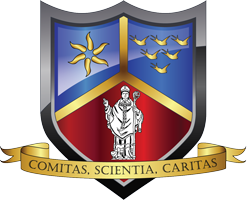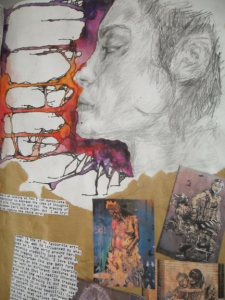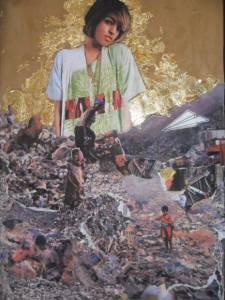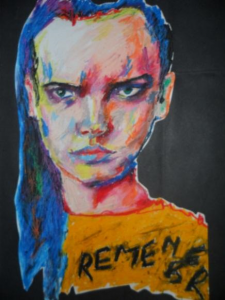Art- accordion
Introduction
St. Richard’s Art Department aims to open all pupils’ eyes to the world and prepare those continuing on with art with the creativity and skills to make a success of higher education. Individuals going into Higher Education and gaining degrees in Art and Design are well-equipped for the world of work. Creative thinkers are highly employable and are much sought after in the world of design, television, media, film, galleries, museums and education. The creative industries are now one of the highest graduate employers in the UK.
Art Essentials
All Key Stage Three pupils receive art lessons that base practical activities on a growing understanding of critical studies. Basic studies in technique and understanding develop in Year 7 into more open ended work that prepares pupils for GCSE by the end of Year 9. Pupils are encouraged to work in GCSE styled sketchbooks during Year 8 and Fine Art pupils may opt to attend extra lessons in term 6 of Year 9 to ensure a smoother transition to GCSE.
Courses
Pupils opt in the latter part of Year 9 for either the AQA Fine Art course or the AQA Art and Design course. Both courses require pupils to develop a portfolio of coursework and complete an externally-set task.
Skills
- Fine Art and Design develops the following skills:
- the ability to research and analyse
- objective drawing, painting and other media techniques
- hand-eye co-ordination
- ability to develop and manipulate ideas and to think laterally in the process of problem-solving
- the ability to express oneself creatively
- Art and Design pupils will be expected to demonstrate skills and techniques in the context of their chosen areas of study within art, craft and design:
- making appropriate use of colour, line, tone, texture, shape and form.
- using different approaches to recording images, such as observation, analysis, expression and imagination.
- showing in their work an understanding of the conventions of representational and abstract/non-representational imagery and genres.
- investigating different ways of working, as appropriate to their chosen areas of study within art, craft and design.
- providing evidence of an understanding of spatial qualities, composition, rhythm, scale and structure.
- providing evidence of the use of safe working practices.
Progression
Pupils may progress on to A level. An A* to C grade in Art and Design is a usual requirement.
A level students usually go on to take a Foundation Course (Diploma in Foundation Studies) prior to university.
The Level One Introductory Diplomas at Sussex Downs can be accessed by interview. The First Level diploma requires 4 D grade GCSE passes and leads on to National Diplomas.
The National Diploma requires four GCSE A* to C grade passes, preferably including English, and an art-based subject and it is an equivalent of three A Level passes. Pupils progress from it on to university degree courses.
Individuals going into Higher Education and gaining degrees in Art and Design are well-equipped for the world of work. Creative thinkers are highly employable and are much sought after in the world of design, television, media, film, galleries, museums and education. The creative industries are now one of the highest graduate employers in the UK. Possible career choices include: artist, designer, sculptor, printmaker, graphic designer, window dresser, fashion design or illustration, architect, TV/film work and the music industry.
The GCSE results for Fine Art were excellent in 2014.The A* to C pass rate was 100% in Fine Art with the A*-A pass rate 86.66% and A*-B pass rate 93.32%.
General Aims
The Department aims to develop the aesthetic and practical capability of each pupil irrespective of ability, sex, colour or creed, through a course that links both the critical and practical domains. Pupils will progress from more teacher-based activities in the lower school to more individual project based work required for GCSE.
The pupils as a method of examining and understanding both their religious and secular environment and other issues that affect their lives should use Art and Design.
Pupils should learn both how to co-operate in working with others whilst independently pursuing their own work.
Pupils should learn through Critical Studies in Art and Design how the latter has affected and been affected by society and try to develop a context within which to place their own practical work. This should also involve pupils in looking beyond our own Western society.
The environment in which the pupils work should foster good working practice matching the needs of numbers to available space, whilst taking care of aspects such as safety, visual stimulation and the availability of working equipment. Also there must be the availability of space, equipment and advice for those pupils wishing to develop their work outside of lesson time.
The Art Department aims to foster links with other departments through Cross Curricular work, with other establishments through competitions and exhibitions and with the home through normal homework and the encouragement of pupils to continue major pieces of work both at home and in school.
Objectives
All Key Stage 3 Year 7 groups will be introduced to a foundation course in Art and Design.
In year 7, 8 and 9 pupils will spend a half a year working in Fine Art and half a year working in Art and Design.
Critical Studies work to be undertaken at KS3 will continue to cover the range of periods from the Egyptians to the present and will include non-western art. Critical Studies will normally be directly linked to practical activities.
Year 7 will continue to be a year in which many basics are taught from drawing and painting and 3D through to research and analysis. A lunchtime club will be available.
Year 8 will broaden the theory learnt in Year 7 with the introduction of far more sight work and the introduction of thematic compositional studies as the basis for 2D and 3D work.
Year 9 pupils will research a variety of topics in relation to the development of art from the 19th century into the 20th Century. They will become more aware of their potential to develop set themes in a more individual way making more use of research material. They will develop work in a way that prepares them for the project work encountered in year 10.
Year 10 and 11 pupils will study either the AQA Fine Art or the Art and Design specification. There will be two groups in Year 10 and two in Year 11. Pupils will receive one double and one single period per week.
Year 10 Fine Art work will develop through a Foundation project covering the traditional areas of objective still life, figure work, and the exterior environment. The First Controlled Assessment will be based on the Externally Set Task set for Year 11. Pupils will move onto their Major Controlled assessment in term six and this will be completed at the end of term 2 in Year 11. Fine Art pupils are able to choose the content of their Major Controlled Assessment.
Year 10 Art and Design pupils will work from two internally set briefs during the first two terms before attempting one of the tasks set in the Externally Set Task for the Year 11 pupils. Pupils will be given a brief for their Major Controlled Assessment in term six and this will be completed at the end of term 2 in Year 11.
Pupils at KS3 are assessed according to levels from one to 10 with their overall marks being broken down into sub-levels.
KS4 pupils are currently marked out of 80 with marks split into four assessment headings. Pupils must submit a portfolio of more than one extended collection of work. The “Portfolio of work including the Controlled Assessment” is worth 60%. The final “Externally set task” is worth 40% of the total marks.
Pupils’ work for the portfolio will be carried out under informal supervision. Research to help the development ideas will be completed with limited supervision. The initial foundation project combining Still-life, Figure and Landscape will be followed by the First Controlled assessment and the Major Controlled assessment. These assessments will offer a choice of subject similar to the “Externally set task” and they will allow pupils to approach that subject in more depth.
These are the four assessment objectives:
- Development of ideas through investigations informed by contextual and other sources demonstrating analytical and cultural understanding.
- Refine their ideas through experimenting and selecting appropriate resources, media, materials, techniques and processes
- Record ideas, observations and insights relevant to their intentions in visual and/or other forms.
- Present a personal, informed and meaningful response demonstrating analytical and critical understanding, realising intentions and where appropriate, making connections between visual, written, oral or other elements.
Each area is marked out of 20. Homework may be marked from one or more of these areas. Portfolio projects are marked under all four areas.
Marks are awarded as follows:
0 Work not worthy of credit
1-4 Minimal ability
5-8 Some ability
9-12 A generally consistent ability
13-16 A consistent ability
17-20 A highly developed ability
The lower mark just reaches the assessment band.
The next mark is adequate for the assessment band.
The next mark is clear evidence of achieving the assessment band.
The next mark is convincing evidence of achieving the assessment band.
Monday and Friday lunchtimes there are supervised art sessions. Pupils further their coursework or work on their own individual ideas. We are pleased to have Miss Sara Howard adding her new Year 7 and 8 Art Club to the after school activities. Pupils also take part in the “Art Champions” programme run by the De La Warr Pavilion.
- Fine Art and Design develops the following skills:
- the ability to research and analyse
- objective drawing, painting and other media techniques
- hand-eye co-ordination
- ability to develop and manipulate ideas and to think laterally in the process of problem-solving
- the ability to express oneself creatively
- Art and Design pupils will be expected to demonstrate skills and techniques in the context of their chosen areas of study within art, craft and design:
- making appropriate use of colour, line, tone, texture, shape and form.
- using different approaches to recording images, such as observation, analysis, expression and imagination.
- showing in their work an understanding of the conventions of representational and abstract/non-representational imagery and genres.
- investigating different ways of working, as appropriate to their chosen areas of study within art, craft and design.
- providing evidence of an understanding of spatial qualities, composition, rhythm, scale and structure.
- providing evidence of the use of safe working practices.
Pupils may progress on to A level. An A* to C grade in Art and Design is a usual requirement.
A level students usually go on to take a Foundation Course (Diploma in Foundation Studies) prior to university.
The Level One Introductory Diplomas at Sussex Downs can be accessed by interview. The First Level diploma requires 4 D grade GCSE passes and leads on to National Diplomas.
The National Diploma requires four GCSE A* to C grade passes, preferably including English, and an art-based subject and it is an equivalent of three A Level passes. Pupils progress from it on to university degree courses.
Individuals going into Higher Education and gaining degrees in Art and Design are well-equipped for the world of work. Creative thinkers are highly employable and are much sought after in the world of design, television, media, film, galleries, museums and education. The creative industries are now one of the highest graduate employers in the UK. Possible career choices include: artist, designer, sculptor, printmaker, graphic designer, window dresser, fashion design or illustration, architect, TV/film work and the music industry.
The GCSE results for Fine Art were excellent in 2014.The A* to C pass rate was 100% in Fine Art with the A*-A pass rate 86.66% and A*-B pass rate 93.32%.
The Department aims to develop the aesthetic and practical capability of each pupil irrespective of ability, sex, colour or creed, through a course that links both the critical and practical domains. Pupils will progress from more teacher-based activities in the lower school to more individual project based work required for GCSE.
The pupils as a method of examining and understanding both their religious and secular environment and other issues that affect their lives should use Art and Design.
Pupils should learn both how to co-operate in working with others whilst independently pursuing their own work.
Pupils should learn through Critical Studies in Art and Design how the latter has affected and been affected by society and try to develop a context within which to place their own practical work. This should also involve pupils in looking beyond our own Western society.
The environment in which the pupils work should foster good working practice matching the needs of numbers to available space, whilst taking care of aspects such as safety, visual stimulation and the availability of working equipment. Also there must be the availability of space, equipment and advice for those pupils wishing to develop their work outside of lesson time.
The Art Department aims to foster links with other departments through Cross Curricular work, with other establishments through competitions and exhibitions and with the home through normal homework and the encouragement of pupils to continue major pieces of work both at home and in school.
All Key Stage 3 Year 7 groups will be introduced to a foundation course in Art and Design.
In year 7, 8 and 9 pupils will spend a half a year working in Fine Art and half a year working in Art and Design.
Critical Studies work to be undertaken at KS3 will continue to cover the range of periods from the Egyptians to the present and will include non-western art. Critical Studies will normally be directly linked to practical activities.
Year 7 will continue to be a year in which many basics are taught from drawing and painting and 3D through to research and analysis. A lunchtime club will be available.
Year 8 will broaden the theory learnt in Year 7 with the introduction of far more sight work and the introduction of thematic compositional studies as the basis for 2D and 3D work.
Year 9 pupils will research a variety of topics in relation to the development of art from the 19th century into the 20th Century. They will become more aware of their potential to develop set themes in a more individual way making more use of research material. They will develop work in a way that prepares them for the project work encountered in year 10.
Year 10 and 11 pupils will study either the AQA Fine Art or the Art and Design specification. There will be two groups in Year 10 and two in Year 11. Pupils will receive one double and one single period per week.
Year 10 Fine Art work will develop through a Foundation project covering the traditional areas of objective still life, figure work, and the exterior environment. The First Controlled Assessment will be based on the Externally Set Task set for Year 11. Pupils will move onto their Major Controlled assessment in term six and this will be completed at the end of term 2 in Year 11. Fine Art pupils are able to choose the content of their Major Controlled Assessment.
Year 10 Art and Design pupils will work from two internally set briefs during the first two terms before attempting one of the tasks set in the Externally Set Task for the Year 11 pupils. Pupils will be given a brief for their Major Controlled Assessment in term six and this will be completed at the end of term 2 in Year 11.
Pupils at KS3 are assessed according to levels from one to 10 with their overall marks being broken down into sub-levels.
KS4 pupils are currently marked out of 80 with marks split into four assessment headings. Pupils must submit a portfolio of more than one extended collection of work. The “Portfolio of work including the Controlled Assessment” is worth 60%. The final “Externally set task” is worth 40% of the total marks.
Pupils’ work for the portfolio will be carried out under informal supervision. Research to help the development ideas will be completed with limited supervision. The initial foundation project combining Still-life, Figure and Landscape will be followed by the First Controlled assessment and the Major Controlled assessment. These assessments will offer a choice of subject similar to the “Externally set task” and they will allow pupils to approach that subject in more depth.
These are the four assessment objectives:
- Development of ideas through investigations informed by contextual and other sources demonstrating analytical and cultural understanding.
- Refine their ideas through experimenting and selecting appropriate resources, media, materials, techniques and processes
- Record ideas, observations and insights relevant to their intentions in visual and/or other forms.
- Present a personal, informed and meaningful response demonstrating analytical and critical understanding, realising intentions and where appropriate, making connections between visual, written, oral or other elements.
Each area is marked out of 20. Homework may be marked from one or more of these areas. Portfolio projects are marked under all four areas.
Marks are awarded as follows:
0 Work not worthy of credit
1-4 Minimal ability
5-8 Some ability
9-12 A generally consistent ability
13-16 A consistent ability
17-20 A highly developed ability
The lower mark just reaches the assessment band.
The next mark is adequate for the assessment band.
The next mark is clear evidence of achieving the assessment band.
The next mark is convincing evidence of achieving the assessment band.
Monday and Friday lunchtimes there are supervised art sessions. Pupils further their coursework or work on their own individual ideas. We are pleased to have Miss Sara Howard adding her new Year 7 and 8 Art Club to the after school activities. Pupils also take part in the “Art Champions” programme run by the De La Warr Pavilion.
